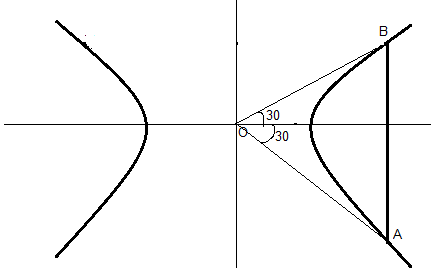
If AB is a double ordinate of the hyperbola $\dfrac{{{{\text{x}}^2}}}{{{{\text{a}}^2}}} - \dfrac{{{{\text{y}}^2}}}{{{{\text{b}}^2}}} = 1$ such that ∆AOB (O is the origin) is an equilateral triangle, then the eccentricity e of the hyperbola satisfies:
$
{\text{A}}{\text{. e > }}\sqrt 3 \\
{\text{B}}{\text{. 1 < e < }}\dfrac{2}{{\sqrt 3 }} \\
{\text{C}}{\text{. e = }}\dfrac{2}{{\sqrt 3 }} \\
{\text{D}}{\text{. e > }}\dfrac{2}{{\sqrt 3 }} \\
$
Answer
605.4k+ views
Hint: According to the given data in the question, we draw an appropriate figure that helps us find the coordinates of points A and B. Also given AOB is an equilateral triangle, i.e. all angles in the triangle are equal to 60°.

Complete step-by-step answer:
Given O (0, 0) is the origin and AB is the double ordinate of the hyperbola i.e. polar coordinates of
A = (a secθ, b tanθ), B = (a secθ, -b tanθ).
Since ∆AOB is equilateral, OA = AB
We use the formula for distance between two points (d$^2$ =${\left( {{{\text{x}}_2} - {{\text{x}}_1}} \right)^2} + {\left( {{{\text{y}}_2} - {{\text{y}}_1}} \right)^2}$), to form a relation OA = AB, which give us
$\sqrt {{{\left( {{\text{asec}}\theta {\text{ - 0}}} \right)}^2} + {{\left( {{\text{-b}}\tan \theta - 0} \right)}^2}} = \sqrt {{{\left( {{\text{asec}}\theta {\text{ - asec}}\theta } \right)}^2} + {{\left( {{\text{btan}}\theta {\text{ - }}\left( { - {\text{btan}}\theta } \right)} \right)}^2}} $
$ \Rightarrow {{\text{a}}^2}{\text{se}}{{\text{c}}^2}\theta + {{\text{b}}^2}{\text{ta}}{{\text{n}}^2}\theta = 4{{\text{b}}^2}{\tan ^2}\theta $
$ \Rightarrow {{\text{a}}^2}{\text{se}}{{\text{c}}^2}\theta = 3{{\text{b}}^2}{\tan ^2}\theta $ -- (1)
We know according to trigonometric identities, ${\text{se}}{{\text{c}}^2}\theta - {\text{ta}}{{\text{n}}^2}\theta = {\text{ 1}}$
Hence${\text{se}}{{\text{c}}^2}\theta = 1 + {\text{ta}}{{\text{n}}^2}\theta $, substitute this in equation (1), we get
${{\text{a}}^2} + {{\text{a}}^2}{\text{ta}}{{\text{n}}^2}\theta = 3{{\text{b}}^2}{\text{ta}}{{\text{n}}^2}\theta $
$ \Rightarrow \dfrac{{{{\text{b}}^2}}}{{{{\text{a}}^2}}} = \dfrac{{1 + {\text{ta}}{{\text{n}}^2}\theta }}{{3{\text{ta}}{{\text{n}}^2}\theta }}$
Now we know for eccentricity ${{\text{e}}^2} = 1 + \dfrac{{{{\text{b}}^2}}}{{{{\text{a}}^2}}}$=$1 + \dfrac{{1 + {\text{ta}}{{\text{n}}^2}\theta }}{{3{\text{ta}}{{\text{n}}^2}\theta }}$=$\dfrac{{1 + 4{\text{ta}}{{\text{n}}^2}\theta }}{{3{\text{ta}}{{\text{n}}^2}\theta }}$
= $\dfrac{4}{3} $ +$\dfrac{1}{{3{\text{si}}{{\text{n}}^2}\theta }}$.
Using${\text{si}}{{\text{n}}^2}\theta {\text{ < 1}}$, we get ${{\text{e}}^2}{\text{ > }}\dfrac{4}{3}$
Hence e >$\dfrac{2}{{\sqrt 3 }}$. Option D is the correct answer.
Note: In order to solve these types of questions the key concept is to carefully draw a precise figure according to the given data. Then we use the figure to derive necessary relations which help us compute the solution. Basic knowledge of geometrical formulae of hyperbola, its eccentricity and trigonometric functions is very important in solving these problems.

Complete step-by-step answer:
Given O (0, 0) is the origin and AB is the double ordinate of the hyperbola i.e. polar coordinates of
A = (a secθ, b tanθ), B = (a secθ, -b tanθ).
Since ∆AOB is equilateral, OA = AB
We use the formula for distance between two points (d$^2$ =${\left( {{{\text{x}}_2} - {{\text{x}}_1}} \right)^2} + {\left( {{{\text{y}}_2} - {{\text{y}}_1}} \right)^2}$), to form a relation OA = AB, which give us
$\sqrt {{{\left( {{\text{asec}}\theta {\text{ - 0}}} \right)}^2} + {{\left( {{\text{-b}}\tan \theta - 0} \right)}^2}} = \sqrt {{{\left( {{\text{asec}}\theta {\text{ - asec}}\theta } \right)}^2} + {{\left( {{\text{btan}}\theta {\text{ - }}\left( { - {\text{btan}}\theta } \right)} \right)}^2}} $
$ \Rightarrow {{\text{a}}^2}{\text{se}}{{\text{c}}^2}\theta + {{\text{b}}^2}{\text{ta}}{{\text{n}}^2}\theta = 4{{\text{b}}^2}{\tan ^2}\theta $
$ \Rightarrow {{\text{a}}^2}{\text{se}}{{\text{c}}^2}\theta = 3{{\text{b}}^2}{\tan ^2}\theta $ -- (1)
We know according to trigonometric identities, ${\text{se}}{{\text{c}}^2}\theta - {\text{ta}}{{\text{n}}^2}\theta = {\text{ 1}}$
Hence${\text{se}}{{\text{c}}^2}\theta = 1 + {\text{ta}}{{\text{n}}^2}\theta $, substitute this in equation (1), we get
${{\text{a}}^2} + {{\text{a}}^2}{\text{ta}}{{\text{n}}^2}\theta = 3{{\text{b}}^2}{\text{ta}}{{\text{n}}^2}\theta $
$ \Rightarrow \dfrac{{{{\text{b}}^2}}}{{{{\text{a}}^2}}} = \dfrac{{1 + {\text{ta}}{{\text{n}}^2}\theta }}{{3{\text{ta}}{{\text{n}}^2}\theta }}$
Now we know for eccentricity ${{\text{e}}^2} = 1 + \dfrac{{{{\text{b}}^2}}}{{{{\text{a}}^2}}}$=$1 + \dfrac{{1 + {\text{ta}}{{\text{n}}^2}\theta }}{{3{\text{ta}}{{\text{n}}^2}\theta }}$=$\dfrac{{1 + 4{\text{ta}}{{\text{n}}^2}\theta }}{{3{\text{ta}}{{\text{n}}^2}\theta }}$
= $\dfrac{4}{3} $ +$\dfrac{1}{{3{\text{si}}{{\text{n}}^2}\theta }}$.
Using${\text{si}}{{\text{n}}^2}\theta {\text{ < 1}}$, we get ${{\text{e}}^2}{\text{ > }}\dfrac{4}{3}$
Hence e >$\dfrac{2}{{\sqrt 3 }}$. Option D is the correct answer.
Note: In order to solve these types of questions the key concept is to carefully draw a precise figure according to the given data. Then we use the figure to derive necessary relations which help us compute the solution. Basic knowledge of geometrical formulae of hyperbola, its eccentricity and trigonometric functions is very important in solving these problems.
Recently Updated Pages
Master Class 11 Chemistry: Engaging Questions & Answers for Success

Why are manures considered better than fertilizers class 11 biology CBSE

Find the coordinates of the midpoint of the line segment class 11 maths CBSE

Distinguish between static friction limiting friction class 11 physics CBSE

The Chairman of the constituent Assembly was A Jawaharlal class 11 social science CBSE

The first National Commission on Labour NCL submitted class 11 social science CBSE

Trending doubts
What is meant by exothermic and endothermic reactions class 11 chemistry CBSE

10 examples of friction in our daily life

One Metric ton is equal to kg A 10000 B 1000 C 100 class 11 physics CBSE

Difference Between Prokaryotic Cells and Eukaryotic Cells

What are Quantum numbers Explain the quantum number class 11 chemistry CBSE

1 Quintal is equal to a 110 kg b 10 kg c 100kg d 1000 class 11 physics CBSE




